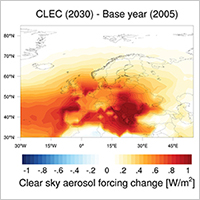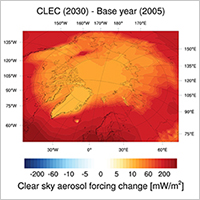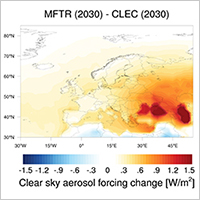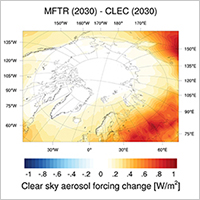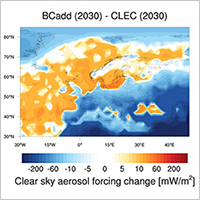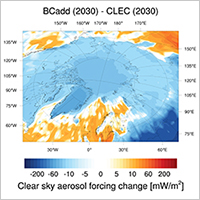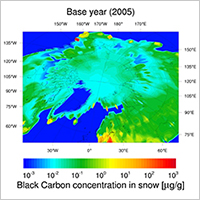

Climate effects
Climate effects of black carbon, organic carbon and sulphur dioxide were simulated, and notable differences in atmospheric absorption and top-of-the-atmosphere aerosol forcing between the different emission scenarios were found. In addition, the amount of black carbon deposition onto snow surfaces and resulting radiative forcing was estimated. The main results of these simulations are discussed below.
Atmospheric absorption
The geographical pattern of atmospheric absorption, or heating, follows that of the black carbon burden, and is further enhanced over the regions with a low surface albedo. Over and downwind large deserted areas, mineral dust contributes to atmospheric absorption. Future changes in atmospheric absorption will be most pronounced over south-eastern China and India with decreases of up to several W/m2. Over central Europe, atmospheric absorption is predicted to decrease by more than 1 W/m2 in the mitigation scenarios MTFR and BCadd, whereas in Arctic areas the decreases remain below 0.1 W/m2 in these scenarios.
Top-of-the-atmosphere forcing
Under present-day conditions, the clear-sky top-of-the-atmosphere (TOA) aerosol forcing is negative almost everywhere in the world, indicating the overall cooling effect of aerosols in the Earth system. The simulations predict a less negative clear-sky TOA forcing (i.e. warming effect) over Europe and most of the Arctic by 2030 compared with present day situation (Fig. 1).The main driver for the change is the future sulfur emission reduction which dominates over the corresponding black carbon emission reduction in terms of the TOA aerosol forcing.
Fig. 1. The change in the clear-sky, top-of-the-atmosphere aerosol over Europe (left) and Arctic areas (right) from the year 2005 to the year 2030 in the reference scenario (CLEC). (Click the map to enlarge)
Differences between the future emissions scenarios are large: compared with the reference scenario (CLEC2030), the mitigation scenario with maximum reduction of black carbon, organic carbon and sulphur dioxide (MTFR) will cause larger increases in the TOA aerosol forcing throughout Europe and Arctic areas (Fig. 2), whereas the mitigation scenario with black carbon oriented measures (BCadd) behaves roughly the opposite way (Fig. 3). This demonstrates the possibilities if emission reductions are targeted to sources with high share of black carbon.
Fig 2. The difference in the clear-sky, top-of-the-atmosphere forcing between the scenarios MTFR and CLEC for the year 2030 over Europe (left) and the Arctic area (right) (Click the map to enlarge)
Fig 3. The difference in the clear-sky, top-of-the-atmosphere forcing between the scenarios BCadd and CLEC for the year 2030 over Europe (left) and the Arctic area (right). (Click the map to enlarge)
In the annual average, the difference in the clear-sky TOA aerosol forcing between the BCadd and MTRF scenarios are predicted to exceed 1 W/m2 over parts of the eastern Europe and 0.1 W/m2 over large areas in the Arctic.
Black carbon on snow
Black carbon deposition onto snow surfaces was calculated for areas where the modeled snow cover was thicker than 5 cm during the base year 2005. The modeled black carbon concentrations in snow are in the range of 100 ng g–1 in northern Scandinavia and western Siberia and in the range of 10 ng g–1 in the central Arctic Ocean sea ice, in large areas of central Siberia and in the northern parts of North America. The lowest concentrations, in the range of 1 ng g–1 were in the upper plateau of Greenland (Fig. 4).
Fig 4. The concentration of black carbon in snow over the Arctic areas averaged over the snow-covered period of the year. (Click the map to enlarge)
The concentrations of black carbon in snow were used for estimating the reduction of snow albedo compared with that of clean snow and the respective radiative forcing. The range of albedo of clean snow is a strong source of uncertainty in the radiative forcing calculations and therefore sensitivity studies were conducted by varying the clean snow albedo in the range of 0.8–0.9. For the latitude range north of 60°N, the resulting radiative forcing was estimated to in the range of 0.37–3.2 W m–2 during the snow-covered period of the year.
Summary of the climate effects
The less negative clear-sky top-of the atmosphere aerosol forcing predicted for the near-future is expected to cause additional warming of both Europe and Arctic areas. Additional warming means the warming that adds to the general global warming caused by greenhouse gases and associated climate feedbacks. This additional warming will be smallest for the BCadd mitigation scenario that targets to mitigation of black carbon rich emissions and clearly largest for the mitigation scenario MTFR that assumes maximum reduction of all aerosol components, especially sulphur dioxide.
The future decrease of atmospheric absorption over Europe and Arctic areas will change vertical temperature profiles during the sunlit months of the year, which may affect the climate by changing atmospheric circulation and cloud properties. These processes are poorly understood and are not estimated here.
In the future, less black carbon will deposit onto snow in both Europe and most of the Arctic areas, the decrease being largest for MTFR and BCadd scenarios. The decreased black carbon snow deposition will mitigate Arctic warming during the spring and summer seasons.
Aerosols affect the Arctic radiation budget also via aerosol-cloud interactions. Future changes in this indirect aerosol forcing are likely to remind those of the clear-sky TOA aerosol forcing during the summer, but the overall magnitude of this forcing is very uncertain. During other seasons over the Arctic, the magnitude and even sign of the aerosol indirect forcing is unknown.


